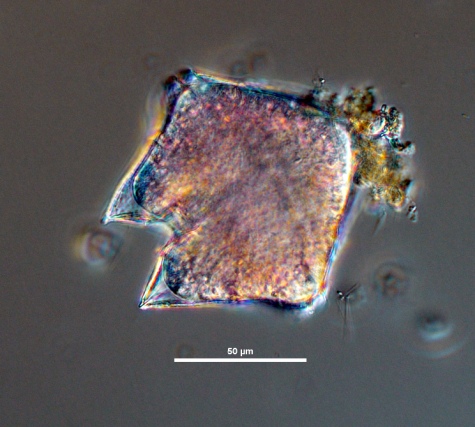
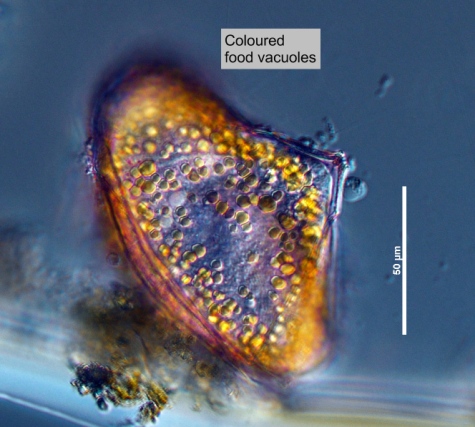
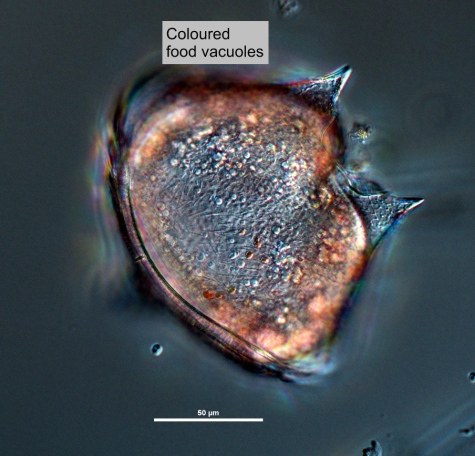
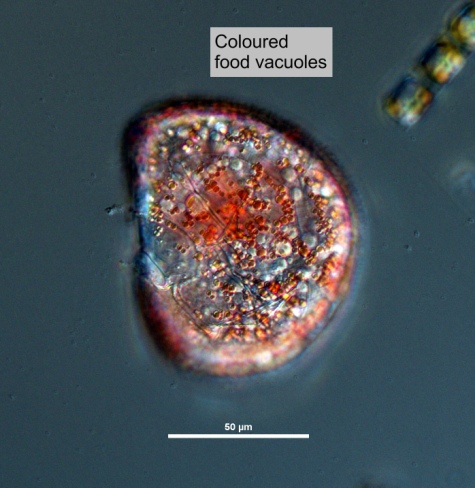
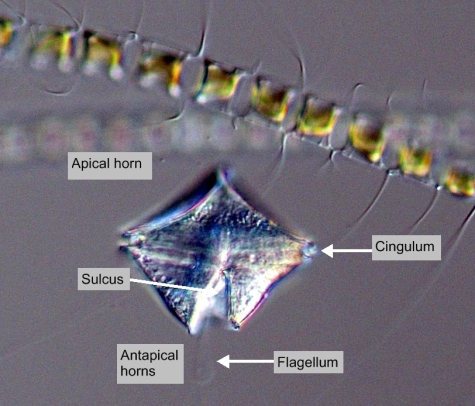
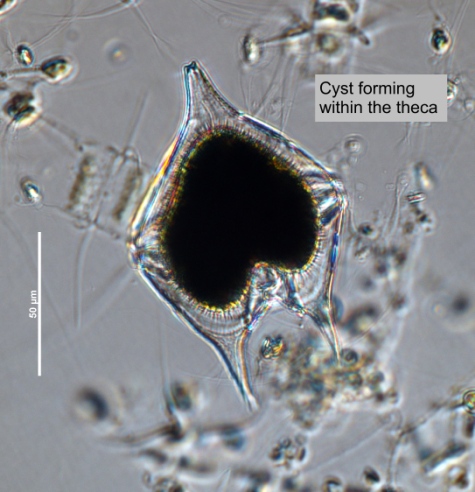
|
 |
Synonym(s)
Protoperidinium claudicans Paulsen 1907
Peridinium claudicans
Votadinium spinosum
(Kraberg et al. 2010, EOL 2012)
Classification
(Guiry and Guiry 2012)
Lifestyle
Cyst
"A thick-walled dormant cell" (Horner 2002).
cyst, which is called Votadinium spinosum Reid in micropaleontological studies, with a thin, brown cell wall (Kraberg et al. 2010). Cells feed by extruding their CloseCytoplasm
In a eukaryotic cell, a gel-like substance within the cell membrane that contains all the organelles except for the nucleus.
cytoplasm out of their theca and engulfing prey items. Once it has absorbed the contents of the prey, it retracts itself back into its theca. This is called ClosePallium
(feeding) A mode of feeding used by some heterotrophic dinoflagellates. The dinoflagellate extrudes its cytoplasm, engulfing its food (often a cell or chain of cells). The food is digested outside the dinoflagellate's cell. The dinoflagellate then pulls its cytoplasm and its newly digested meal back inside its theca. This method of feeding allows dinoflagellates to eat food that is bigger than itself.
pallium feeding (Menden-Deuer et al. 2005).Description
Epitheca
In thecate dinoflagellates, the anterior part of a dinokont cell above the cingulum. The equivalent of epicone for naked dinoflagellates.
epitheca forms a short CloseApical
(axis, spine) The region of the apex or point. Refers to the most anterior point or region of the cell (HPP 2003).
apical CloseHorns
The apical or antapical extensions found in some armoured dinoflagellates; they contain cytoplasm, are covered in thecal plates and can be hollow or partially solid (Horner 2002).
horn. The CloseHypotheca
In thecate dinoflagellates, the posterior part of a dinokont cell above the cingulum. The equivalent of a hypocone for naked dinoflagellates.
hypotheca forms two short, tubular and pointed CloseAntapical
Referring to the most posterior point of a cell. The opposite of apical.
antapical horns. The left antapical horn is always shorter than the right (Evagelopoulos 2002). The sides of the cell bulge out around the CloseCingulum
(dinoflagellates) "In dinokont dinoflagellates, a furrow encircling the cell one or many times" (Horner 2002). It is also known as the girdle or transverse groove and may be located at, above, or below the midpoint of the cell with the left and right ends meeting or displaced form one another (Horner 2002). In diatoms, this term describes the collective elements of a diatom girdle: "The cingulum is made up of delicate silica bands that join the two valves of a frustule. Most diatoms possess a cingulum, although some may not" (Spaulding et al. 2010).
cingular lists.Measurements
Width: 48 - 75 μm
(Kraberg et al. 2010)
Similar species
Harmful effects
Habitat
Estuary
The area where a river meets the ocean. Often characterized by high sediments, high nutrient levels, salinity fluctuations and tidal mixing.
estuaries as well (Steidinger and Tangen 1997).Distribution
This is a cosmopolitan species that is found in temperate to tropical waters (Steidinger and Tangen 1996). It has been seen in the Atlantic and Pacific Oceans and in the North Sea (Kraberg et al. 2010).
It is commonly seen from spring to summer (Kraberg et al. 2010).
Growth conditions
Environmental Ranges
Temperature range (°C): 18.405 - 20.934
Nitrate (μmol L-1): 0.846 - 8.908
Salinity: 33.852 - 35.624
Oxygen (mL L-1): 4.709 - 5.491
Phosphate (μmol L-1): 0.179 - 1.452
Close
Silicic acid
A general term to describe chemical compounds containing silicon, oxygen and hydrogen with a general formula of [SiOx(OH)4-2x]n. Diatoms polymerize silicic acid into biogenic silica to form their frustules (Azam and Chisholm 1976).
Silicate (μmol L-1): 1.030 - 12.403(EOL 2012)
Bloom characteristics
References
Encyclopedia of Life (EOL 2012). 2012. Protoperidinium claudicans (Paulsen) Balech 1974. http://eol.org/pages/899429/details. Accessed 27 March 2012.
Evagelopoulos, A. 2002. Taxonomic notes on Protoperidinium (Peridiniales, Dinophyceae) species in the Thermaikos Bay (North Aegean Sea, Greece). Mediterranean Marine Science. 3/2: 41-54.
Guiry, M. D. and Guiry, G. M. 2012. P. claudicans (Paulsen) Balech 1974. http://www.algaebase.org/search/species/detail/?species_id=54641. Accessed 27 March 2012.
Kraberg, A., Baumann, M. and Durselen, C. D. 2010. Coastal Phytoplankton Photo Guide for Northern European Seas. Verlag Dr. Friedrich Pfeil, Munchen, Germany. 203.
Menden-Deuer, S., Lessard, E. J., Satterberg, J. and Grunbaum, D. 2005. Growth rates and starvation survival of three species of the pallium-feeding, thecate dinoflagellate genus Protoperidinium. Aquatic Microbial Ecology. 41: 145-152.
Steidinger, K. A. and Tangen, K. 1997. Dinoflagellates. In: Tomas, C. R. (ed.) Identifying Marine Phytoplankton. Academic Press, Inc., San Diego. 429.
